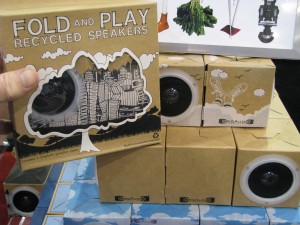Last month, like most consumers, I fell victim to “wrap rage” as I attempted to pry various gifts out of the theft-resistant clamshell packages in which they were packed. MeadWestvaco’s Natralock® is getting some attention at CES, a tradeshow featuring thousands of consumer products manufacturers, with a packaging system that is less paranoid but still secure. The secret is a cardboard backing containing an impossible-to-tear inner layer of film that can also include a security chip. Thus the plastic clamshell overlays attached to the card can be simpler and cheaper, display the product better, and because they are smaller they are less expensive to store and ship and gentler on their ultimate destination, the landfill.
Speaking of landfill, I asked Todd McDonald of Tegrant, the partner that manufactures the card backing and the system used to attach it to the package, what if I wanted to make my clamshell out of cornstarch plastic (which I learned is technically called PLA) so it would decompose? Consumer electronics companies wouldn’t do that, he explained, because it isn’t as transparent so the product doesn’t look as good. More important, PLA melts at high temperatures such as inside a warehouse in Texas in summer.
Also, he went on to explain, virtually no PLA actually gets decomposed anyway because it goes right into landfill where it is undesirable to have decomposition. That’s because decomposition produces methane, which can make the soil unstable and is also a greenhouse gas. Methane produced in a controlled environment, where it can be converted to fuel, is a good thing but landfills can’t do that. Landfills don’t decompose. When one is occasionally excavated, the headlines on 50s newspapers are still readable.
Todd, who is a Certified Packaging Professional (CPP) went on to describe his reservations with PET, the plastic now used universally for food containers because it is recyclable. The problem is, again, that virtually none of this plastic actually gets recycled; unless it’s got a deposit on it, it goes into the landfill. And PET takes twice as much petroleum in manufacturing as the PVC it replaces. A complex tradeoff.

Meanwhile, across the hall in the digital lifestyle pavilion, www.OrigAudio.com (“the origami of audio”) is going in the opposite direction with an audio speaker made out of recycled cardboard—a cardboard box, in other words. You can get two of them for $19.95. Or if you prefer you can make your own speaker from any old resonant trash you may have lying around with the $49.95 Rock-It, a vibration speaker system that attaches to a cereal box, a milk carton or an inflated plastic bag and creates vibration in the object to generate sound. No clamshell packaging is used for either product.